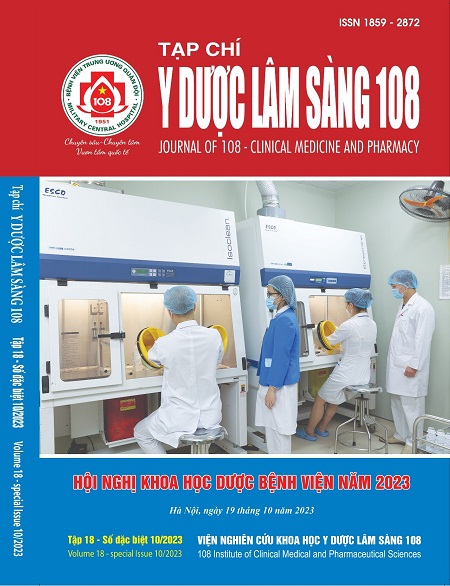Evaluating effect of conversion between original and generic on tacrolimus trough level in kidney transplant patients at 103 Military Hospital
Main Article Content
Keywords
Abstract
Objective: To analyze the characteristics of conversion between original and generic tacrolimus and the effect of that coversion on tacrolimus trough concentrations. Subject and method: A descriptive retrospective method, 6 months longitudinal follow-up of outpatient kidney transplant patients who were re-examied from 11/7/2022 at 103 Military Hospital to 17/7/2022. Result: A total of 241 kidney transplant patients received tacrolimus in the study. In which, the number of patients who continiously maintained the original, generic and switched between original and generic tacrolimus were 66, 29, 146 patients, respectively. The dose of original drug tended to be lower than generic drug. The median tacrolimus trough level after conversion from original to generic formulation was statistically significantly lower (5.4 vs 6.4ng/ml, p=0.0012). The switched patients had the lower time in the target range than the group of continued original tacrolimus (OR = 0.35, 95% CI: 0.16-0.76, p=0,01). Conclusion: Converion of tacrolimus had an effect on tacrolimus concentrations and time in the target range.
Article Details
References
2. Van Gelder T (2011) European society for organ transplantation advisory committee recommendations on generic substitution of immunosuppressive drugs. Transplant International 24(12): 1135-1141.
3. Baker RJ, Mark PB, Patel RK, Stevens KK, Palmer N (2017) Renal association clinical practice guideline in post-operative care in the kidney transplant recipient. BMC Nephrology 18(1): 174.
4. Rosendaal FR, Cannegieter SC et al (1993) A method to determine the optimal intensity of oral anticoagulant therapy. Thrombosis and haemostasis 69(03): 236-239
5. Davis S, Gralla J, Klem P, Tong S, Wedermyer G, Freed B, Wiseman A, Cooper JE (2018) Lower tacrolimus exposure and time in therapeutic range increase the risk of de novo donor-specific antibodies in the first year of kidney transplantation. American Journal of Transplantation 18(4): 907-915.
6. Kirking DM, Ascione FJ et al (2001) Economics and structure of the generic pharmaceutical industry. J Am Pharm Assoc (Wash) 41(4): 578-84.
7. McDevitt-Potter LM, Sadaka B, Tichy EM, Rogers CC, Gabardi S (2011) A multicenter experience with generic tacrolimus conversion. Transplantation 92(6): 653-657.
8. Marfo K, Aitken S et al (2013) Clinical outcomes after conversion from brand-name tacrolimus (prograf) to a generic formulation in renal transplant recipients: A retrospective cohort study. PT 38(8): 484-488.
9. Momper JD, Ridenour TA et al (2011) The Impact of conversion from prograf to generic tacrolimus in liver and kidney transplant recipients with stable graft function. American Journal of Transplantation 11(9): 1861-1867.
10. Yin S, Huang Z, Wang Z, Fan Y, Wang X, Song T et al (2021) Early monitoring and subsequent gain of tacrolimus time-in-therapeutic range may improve clinical outcomes after living kidney transplantation. Ther Drug Monit 43(6): 728-735.
11. Brunet M, van Gelder T, Asberg A, Haufroid V, Hesselink DA, Langman L et al (2019) Therapeutic drug monitoring of tacrolimus-personalized therapy: second consensus report. Ther Drug Monit 41(3): 261-307.
 ISSN: 1859 - 2872
ISSN: 1859 - 2872
